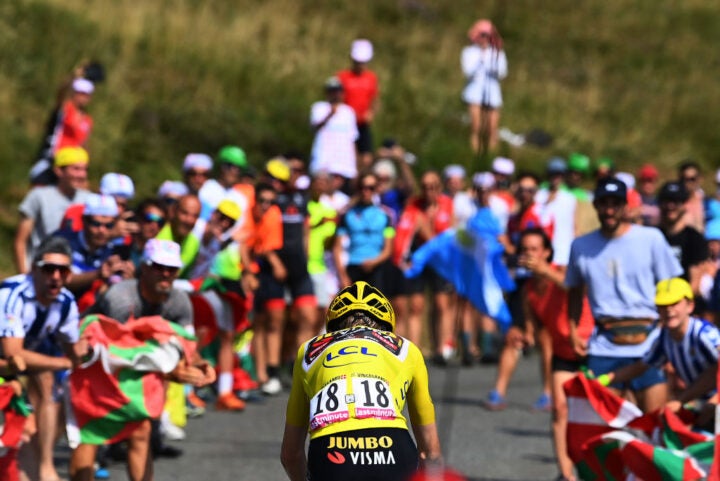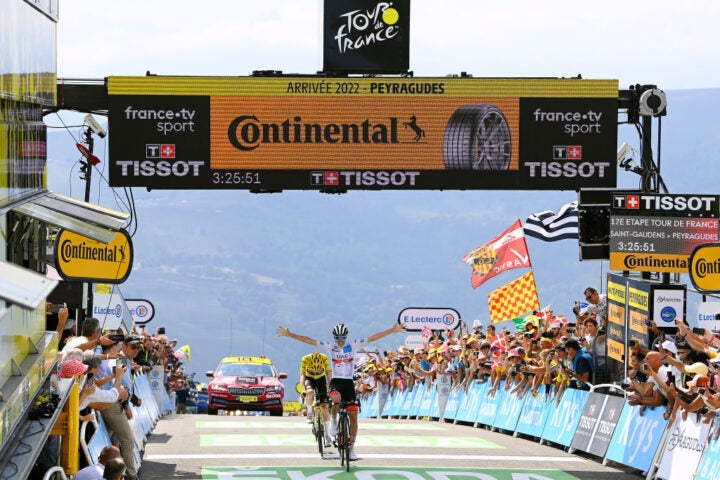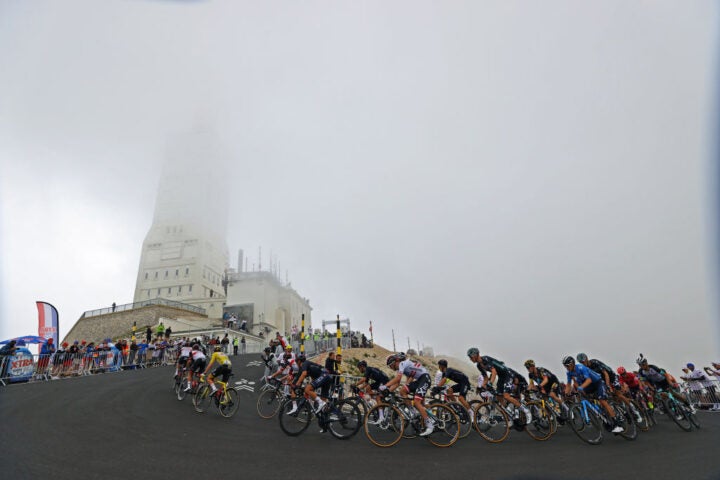After Pogačar won the Critérium du Dauphiné, the stage is set for an intriguing Tour de France. While the numbers at the Dauphiné were not exactly ground-breaking, most riders headed to altitude post-Dauphiné to search out the final fitness boost that would help them reach their peak.
In 2024, we witnessed one of the greatest climbing performances in cycling history when Pogačar climbed Plateau de Beille at nearly 7w/kg for 40 minutes.
While this year’s Tour doesn’t feature the Plateau de Beille, it does include several famous climbs, such as the Hautacam, Peyragudes, and Mont Ventoux.
In this article, we’ll take a detailed look at each of these climbs, and predict the new record times that we could see at this year’s Tour.
Stage 12 – Hautacam

The Hautacam is a legendary Pyrenean climb that will feature on Stage 12 of this year’s Tour. Stretching 13.8 km with an average gradient of 7.8%, Hautacam is one of the hardest climbs in the Tour, featuring multiple pitches steeper than 10%.
The Hautacam also featured the final tipping point of the 2022 Tour de France, where Jonas Vingegaard dropped Pogačar for good. Wout van Aert did the lead out on Hautacam, creating a legendary moment in which the green jersey led out the yellow jersey on an 8% gradient.
At the time, it was one of Vingegaard’s best climbing performances. But the Dane has since surpassed that mark, which was an estimated 6.2w/kg for 36 minutes and 33 seconds. That was Stage 18 of the 2022 Tour, a route which had already featured the Col d’Aubisque and Col de Spandelles.
In this year’s Tour, Hautacam comes at the end of an 181km stage which also features the Col du Soulor (11.8km at 7.7%) and Col des Borderes (3.2km at 8.1%). Logic says there shouldn’t be much fatigue in the rider’s legs by the foot of Hautacam, but in this day and age, you never know how the peloton will race it.
If we extrapolate Vingegaard’s and Pogačar’s career-best performances from 2024, we are looking at 6.9-7.1w/kg for 32-35 minutes. That would smash the Hautacam record, especially since the bikes, tires, and equipment have also gotten faster.
When Vingegaard attacked in 2022, he rode the final 5.5km of the Hautacam at ~6.6w/kg. This year, we can expect an even faster pace for the entire climb.
The benchmark: Hautacam in 2022
Vingegaard – Hautacam in the 2022 Tour de France
Time: 36:33
Estimated Average Power: ~6.2w/kg
Estimated Average Power for the final 5.5km: ~6.6w/kg for 11:51
2025 Tour de France Prediction: 6.7-7.1w/kg for 32-35 minutes
Stage 13 – Peyragudes Individual Time Trial

Less than 24 hours after the Hautacam, this year’s Tour will feature another iconic climb in the Peyragudes.
This stage could produce some of the highest 20-30 min w/kg numbers in cycling history because it is an individual time trial.
There is only a 2.9km run-in before the riders will begin climbing the Peyragudes, an 8.1km climb with an average gradient of 7.5%. However, the gradient is very irregular, alternating between gradients of 20% followed by flat sections.
American cycling fans may remember the Peyragudes from the 2022 Tour, where Brandon McNulty did the best climbing performance of his career.
McNulty did 428w (6.4w/kg) on the penultimate climb of the stage, the Col de Val Louron-Azet, dropping everyone but Vingegaard and Pogačar. After a fast descent, McNulty came to the front on the Peyragudes to lead out Pogačar. He set the pace for the entire climb, only getting dropped on the final 15% ramp to the line.
After a ridiculously hard stage, the American did 400w for 20 minutes and 18 seconds on the Peyragudes. Pogačar won the stage in front of Vingegaard, with both riders crossing the line 22 seconds faster than McNulty.
We will see much faster climbing times in this year’s Tour, not only because the riders have gotten stronger, but also because they will be doing a fresh effort in the individual time trial. This climb is reminiscent of stage 6 of the 2024 Tour de Suisse, in which the route was shortened to just 43 kilometers due to weather.
After a downhill run-in, the peloton climbed straight up the Blatten to the finish. At 7.1km with an average gradient of 9.1%, the Blatten climb lasted just under 20 minutes, similar to what we’ll see on the Peyragudes.
Adam Yates won the stage that day ahead of João Almeida, with both riders pushing an estimated 7.1w/kg for just under 20 minutes. It will be amazing to see what Pogačar, Vingegaard, and Remco Evenepoel can do on the Peyragudes.
The benchmark: Peyragudes in 2022
Pogačar and Vingegaard – Peyragudes in the 2022 Tour de France
Time: 19:46
Estimated Average Power: ~6.1w/kg
2025 Tour de France Prediction: 7.4-7.6w/kg for 17-18 minutes
Stage 18 – Mont Ventoux

Mont Ventoux is one of the most famous climbs in all of cycling. It is the climb where Chris Froome famously ran a few hundred meters, Wout van Aert won an incredible stage in 2021, and Vingegaard dropped Pogačar for the first time in the Tour.
Van Aert’s stage win was the last time that Mont Ventoux was featured in the Tour. That was stage 11 of the 2021 Tour, which featured a double ascent of Ventoux before finishing at the bottom of the descent in Malaucène.
In this year’s Tour, Mont Ventoux serves as the summit finish on stage 16. It is the day after the final rest day, and riders will have a long warmup before reaching the base of the 19.5 km climb. There is hardly a hill along the 150 km run-in to Ventoux, meaning that riders will have relatively fresh legs for the hour-long ascent.
The Bédoin Route is the classic Mont Ventoux ascent (there is more than one route to the summit), and that’s what we will see in this year’s Tour.
The fastest ascent of Mont Ventoux on record is 55 minutes and 51 seconds from 2004. In the modern cycling era, Froome and Vingegaard have some of the fastest ever times, climbing Ventoux in just over 59 minutes. It has been a long time since Ventoux featured a true summit finish, and no one has gone under 58 minutes since the 1990s and early 2000s.
But this year, the stage is set for an all-time climbing record. Coming after the rest day and featuring a flat run-in to the climb, the conditions are primed for an all-out battle. While previous Ventoux’s have featured tactical battles, this year’s ascent could be full gas from the start of the climb.
If any rider is showing signs of cracking, they will be exposed on Ventoux’s hour-long ascent. The last 7 km of Ventoux climb from 1450 m to 1894 m, and feature a wide-open landscape that is completely exposed to the heat.
Vingegaard climbed Ventoux in 59 minutes and 15 seconds in 2021, but that stage didn’t finish at the summit. This year, we can expect to see times around 54-56 minutes depending on the wind and other weather conditions. Last year, we saw Pogačar push nearly 7w/kg for 40 minutes. In stage 16 of this year’s Tour, could we see close to 7w/kg for an hour?
The benchmark: Mont Ventoux in 2021
Vingegaard – Mont Ventoux in the 2021 Tour de France
Time: 59:15
Estimated Average Power: ~6w/kg
2025 Tour de France Prediction: 6.5-6.9w/kg for 53-56 minutes
Power Analysis data courtesy of Strava
Strava sauce extension
Riders:
